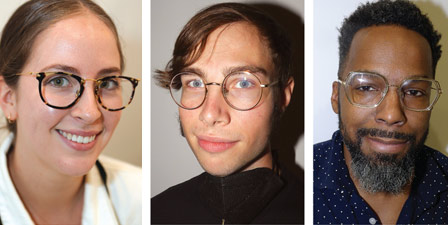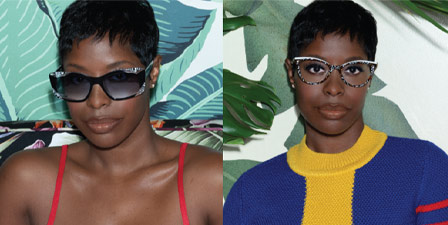In his opening comments, Spina placed emphasis on the big picture—the male customer’s evolving sense of style, recent changes in his shopping patterns and his relationship to the products he buys. “But it’s also much, much more. It’s about being stylish without going too far. And in terms of the people in this room today, it’s about understanding the trends and when and how to push them. Eyewear is, after all, a medical device, but it’s a medical device with style and fashion attributes and as such has become a lifestyle accessory,” Spina notes.

A focal point of the discussion was how men’s buying patterns are changing. “In the past five years, men have become more like women in how they shop,” says del Vecchio. “They are now starting to shop for themselves and showing an interest in the way they look in contrast to dressing the way they were told as they did in the past. This has been good for manufacturers and retailers because it has motivated us to put more new product out there.”
Beiner agrees. “We have come a long way in selling to men,” he says. “Just a few years ago, there was a big difference in what we sold to men in their 20s and those in their 50s. That’s no longer the case. Now it’s all about lifestyle. People who are seniors demographically don’t necessarily look or feel like seniors. This is a change that has taken place across the country, not just in major cities. Today, places like Dubuque, Iowa, carry the same product mixes we do in Miami. That didn’t used to be the case.”
Technology has clearly helped in providing men with appealing eyewear options. “Because of advanced technology, there’s no limit to what we can do with eyewear today,” Barnes says. “We can now add intricate patterns and textures to frames— often difficult or impossible in the past.” What Barnes found especially beneficial about adding eyewear to her product offerings is that it allows her business to reach a much wider and more varied audience. “Men are less conservative with an accessory like a tie or an eyeglass than they are with suits or shirts,” she adds. She also feels it helps in selling to men if men’s eyewear looks like men’s eyewear. “There shouldn’t be any gender confusion.”
Another factor that has helped the eyewear industry enormously is the growth of the sunglass market. “Sunglasses have reinvented the optical industry,” says Kuwahara. “Both men and women are insecure in purchasing eyewear. They rely on opinions from partners, friends, family members, the expertise of the optician and optometrist. But they are more confident when it comes to selecting sunglasses and that has helped build their confidence in purchasing eyeglass frames.” As a result, it is essential for optical practices to have a mix of sun and ophthalmic. “They complement each other. And actually there has been morphing between what’s a frame and what’s a sunglass,” Kuwahara notes. “Now we can take product out of context and offer an ophthalmic style as a sunglass. That’s something fresh.”
Sunglasses define the style of his retail business, Beiner confirms. “People come into our stores looking for fashion and luxury. They find it in the sunwear. Luxury is a key factor in eyewear and it’s reflected by a variety of elements, the brand, the design, the materials—gold, wood, horn. Sunglasses define eyewear and luxury further defines it,” the retailer says.

Bryan, too, feels luxury is a crucial part of today’s marketplace. “We are witnessing a return of sartorial dressing: the three-piece, the double-breasted suit, a greater emphasis on dress accessories such as tie bars, cuff links, pocket squares, tailored hats—tailoring is actually a key word. Men are looking for a more put-together look,” he comments. And this interest in luxury is extending to all areas of men’s products, not just suits—but to cashmere sweaters, silk ties, accessories in general, he says.
Bryan also believes brand names, a major factor in the optical world, are more important than ever. “Everything is a brand today—from designers to performers, sports figures, actors, rock stars, even architects license their names. People define themselves by the brands that are part of their lifestyle.”
Although buying patterns are changing for male consumers, the panelists would like to see additional changes. “Eyewear is more of a fashion accessory than it was in the past, but for it to be a true accessory, we need a shorter buying cycle for eyewear and, for that to happen, we need to reduce the overall price,” Kuwahara states. “In fashion today, the mix of high and low is important. We need that same mix in eyewear. Quality is essential in eyewear, but it is not as important in achieving the right look.”
In his stores, Beiner sees movement in a positive direction. He says the buying cycle for men has become even shorter than the average two years cited for women. “In the past few years, we have also seen a synergy develop between quality and fashion. From a fashion point-of-view, people need more than one pair of eyewear for their lifestyle. It’s up to us to stock product that covers a lot of trends. Some customers follow trends; others want to experiment. This is true for men as well as women,” he emphasizes.
Barnes agrees, although she feels her customers are more individualistic and artistic and less influenced by trends. “I use trends as a broad stroke. I know, for example, eye shapes are getting bigger, but we also have to keep in mind those with smaller heads. Color is my thing,” the designer notes.

This panel was a segment of the “Modern Man” series featured in 20/20 and Vision Monday this spring and co-sponsored by Avalon Eyewear, Colors in Optics, Eyewear Designs, Kenmark Group, Luxottica Group, Marchon Eyewear, Rem Eyewear, Tura and Viva International Group.













